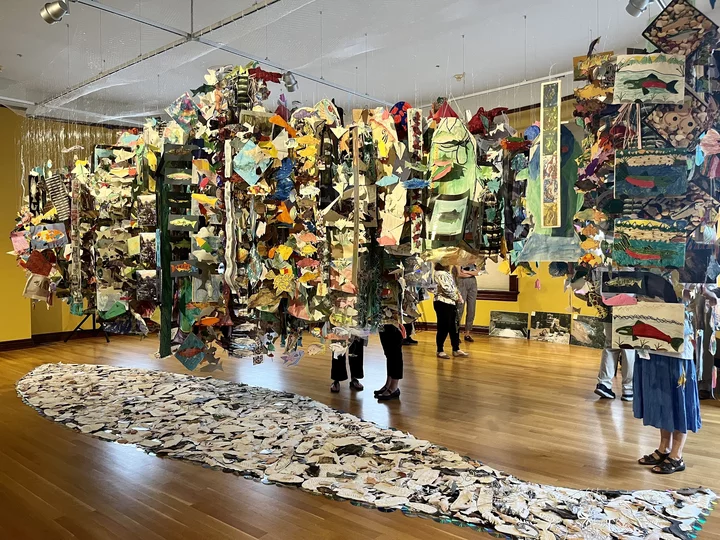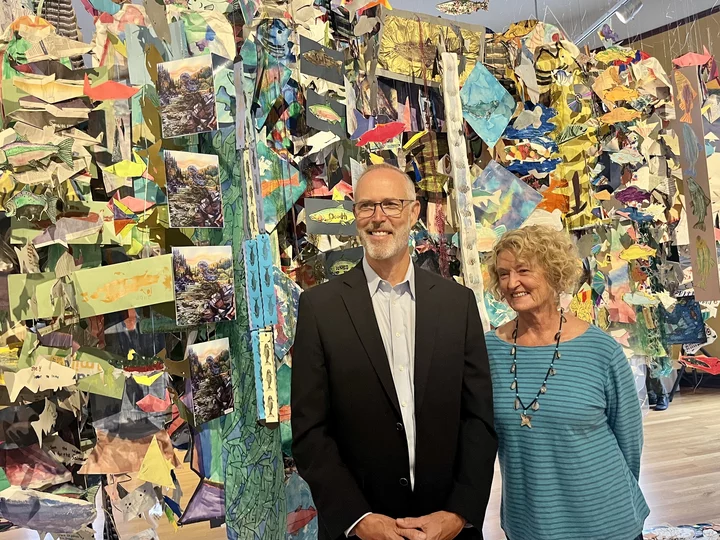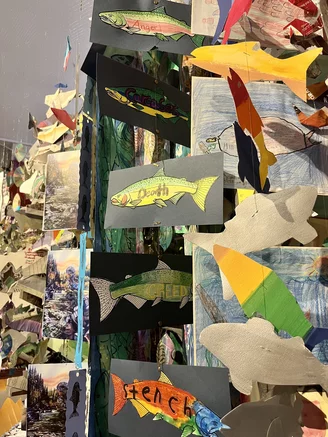The “30,000 Salmon” Art Installation at the Morris Graves Museum of Art in Eureka | Photos: Stephanie McGeary
###
After nearly two decades sitting in boxes in an attic, “30,000 Salmon” — a huge, collaborative art installation — is again seeing the light of day and has been reinstalled at Morris Graves Museum in celebration of the removal of the dams on the Klamath River.
Congressman Jared Huffman, who has helped support the dam removal efforts, came to an advanced look at the installation on Thursday morning, joined by artists, teachers and community members who contributed to the project.
Huffman has been working to support Klamath River restoration efforts since he was elected to Congress 11 years ago, he said. Though there is still a lot of work to be done and the reemergence of this installation comes at a time when the Klamath’s salmon population is among the lowest on record and salmon fishing season has been officially canceled, he is happy to see the dam removal process finally moving forward after decades of the process struggling through political red tape.
“I think there’s a powerful message here,” Huffman told the Outpost while gazing at the piece, which hangs from the ceiling in the middle of the museum. “We’ve kind of come full circle, but in a better way because this year we’re celebrating the removal of the Klamath dams. And we still haven’t fixed all the problems on the Klamath River, but getting these dams out is the biggest piece of bringing these rivers back to life.”
Rep. Jared Huffman and artist Becky Evans
The installation was first put together in 2002 by local artist Becky Evans as a response to the devastating Klamath River fish kill that left more than 30,000 salmon dead (around 30,000 was the initial number reported, but later counts estimated that upward of 70,000 salmon died) as a result of water diversion to the Klamath Basin during a drought year.
To bring attention to the ecological disaster, Evans reached out to artists, teachers and students around Humboldt to help contribute to the art project. The result was 30,000 individual pieces, including drawings, cutouts, papier-mâché and ceramics suspended in the shape of a fish, with objects below. Originally, the art exhibit was installed at the now-closed First Street Gallery in Old Town Eureka
At the time of the original installation, Evans told the Outpost, former North Coast Rep. Mike Thompson extended an invitation to take the installation to be displayed in D.C. But after Evans and her assistants boxed up the entire piece, it turned out that there was not enough space or money to transport the piece to the capitol. So, Evans put the deconstructed sculpture pieces in her attic, where they sat for 19 years.
“My idea was to save it all until the dams come down, if I live that long,” Evans told the Outpost at the Morris Graves on Thursday. “And I’m happy to have lived that long.”
Several of the teachers whose students had contributed to the original project were present to view the sculpture, including Moureen McGarry, who taught art at Sunset Elementary at the time of the original installation. McGarry’s kindergarten, first grade and second grade classes created ceramic pieces, which are scattered in a fish shape on the gallery floor. Students in her after-school art program also painted salmon designs on swaths of silk that are hanging among the thousands pieces of fish art.
“It was a really important educational moment for [the students] to recognize that there is an impact in what we do as humans to this planet and that it affects all of us,” McGarry told the Outpost, recalling what the process was like for her students so many years ago.
Lee Roscoe-Bragg, who taught at Zane Middle School, had her seventh-graders create a series of fish kites for the project back in 2002 and said that she is thrilled to see the pieces displayed again, adding that she remembers how much the students enjoyed viewing the installation the first time it went up. She hopes that some of those students, who are now full-grown adults, will be able to come see the piece again at the Morris Graves.
“The students were very enthusiastic,” Roscoe-Bragg said. “While they didn’t understand exactly how it was all going to come together, they were really excited to be part of such a huge contribution.”
The installation is also accompanied by a short documentary film created by married couple Ken Magnuson and Barbara Morrison that highlights the original project and the catastrophic event that inspired it. Magnuson and Morrison edited the full 25-minute film down to a 10-minute feature that plays on a loop next to the exhibit.
If you would like to view “30,000 Salmon,” the exhibit officially opens to the public this Saturday, Aug. 5 and will be on display at the Morris Graves Museum of Art — 636 F Street, Eureka — through Sep. 19. Evans hopes that those who help contribute to the piece and other members of the community will come to experience this impressive work that both illustrates the devastation that occurred on the Klamath River and celebrates the progress that has been made since.
“It’s about all the people who contributed and all the people in the tribes, in the agencies – the individuals who have not given it up and worked so hard for so many years,” Evans said. “It just brings tears to my eyes that this has happened and I’m considering this a celebration.”
###
NOTE: This article has been changed to reflect that 30,000 was the initial number of salmon reported dead on the Klamath in 2002, and this is why Evans’ project focused on that number. Other counts estimated that upwards of 70,000 salmon died.



CLICK TO MANAGE